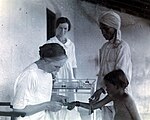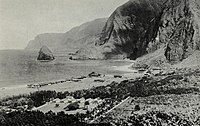| It has been suggested that this article be merged into Hydnocarpus pentandrus. (Discuss) Proposed since August 2024. |
| Chaulmoogra | |
|---|---|
| Scientific classification | |
| Kingdom: | Plantae |
| Clade: | Tracheophytes |
| Clade: | Angiosperms |
| Clade: | Eudicots |
| Clade: | Rosids |
| Order: | Malpighiales |
| Family: | Achariaceae |
| Genus: | Hydnocarpus |
| Species: | H. wightianus |
| Binomial name | |
| Hydnocarpus wightianus Blume | |
Hydnocarpus wightianus or chaulmoogra is a tree in the Achariaceae family. Hydnocarpus wightiana seed oil has been widely used in traditional Indian medicine, especially in Ayurveda, and in Chinese traditional medicine for the treatment of leprosy. It entered early Western medicine in the nineteenth century before the era of sulfonamides and other antibiotics for the treatment of several skin diseases and leprosy. The oil was prescribed for leprosy as a mixture suspended in gum or as an emulsion.
Common names
Common name: Jangli almond
- Hindi: कालमोगरा Calmogara, Chalmogra, Chaulmoogra, Jangli badam
- Kannada: Chalmogra yenne mara, Mirolhakai, Surti, Suranti, Toratti, Garudaphala
- Malayalam: Kodi, Maravatty, Marotti, Nirvatta, Nirvetti
- Marathi: Kadu Kawath
- Sanskrit: Tuvaraka, Turveraka, Tuvrak, कुष्टवैरी Kushtavairi
- Tamil: Maravetti, Maravattai, Marotti
- Telugu: Niradi-vittulu
Habitat
In India: It grows in tropical forests along western Ghats, along the coast from Maharashtra to Kerala, Assam, Tripura, often planted on road sides in hilly areas.
Other countries: The tree is found in South East Asia, chiefly in the Indo-Malayan region, and cultivated in Sri Lanka, Nigeria and Uganda.
Morphology
This is a semi-deciduous tree which grows up to 10 m (33 ft) tall. Bark is brownish, fissured; blaze pinkish. Branch lets are round, minutely velvet-hairy. Leaves are simple, alternate, carried on 0.7–2.2 cm (0.28–0.87 in) long stalks. Leaves are 8 cm–23 cm × 3.5 cm–10 cm (3.1 in–9.1 in × 1.4 in–3.9 in), usually oblong to elliptic-oblong, tip long-pointed, often falling off, base narrow, margin toothed, papery, hairless. Midrib is raised above, secondary nerves 5–7 pairs. Its flowers have greenish white petals and are borne in short cymes or racemes, or sometimes appear by themselves in leaf axils. The flowering takes place from to January to April. Its berries are woody, round, tomentose, about 6–10 cm (2.4–3.9 in) in diameter, and start off black when young but become brown when they mature. They have numerous seeds.
Trees of the species that yield Chaulmoogra oil grow to a height of 12–15 m (39–49 ft) and in India trees bear fruits in August and September. The fruits are ovoid some 10 cm (3.9 in) in diameter with a thick woody rind. Internally they contain 10–16 black seeds embedded in the fruit pulp. The seeds account for some 20% of the fruit weight. A typical tree produces 20 kg (44 lb) of seed/annum. The kernels make up 60–70% of the seed weight and contain 63% of pale yellow oil (mukherjee).
Chaulmoogra oil

The oil from the seeds of Hydnocarpus wightianus (Chaulmoogra) has been widely used in various forms of traditional Indian medicine and in Chinese traditional medicine for the treatment of leprosy. The oil was introduced into England by Frederic J. Mouat and it was used in its raw form both as topical and internal medicine.
The chemical constituents of the oil were analyzed for their potential pharmacological activity by Frederick Belding Power, working for Wellcome Chemical Research Laboratories, in 1904. Power and colleagues isolated hydnocarpic acid, which has the formula C16H28O2, from seeds of both the Hydnocarpus wightiana and Hydnocarpus anthelmintica trees. They introduced the extract into medical usage until sulfones and antibiotics became more dominant in the treatment of several skin diseases and leprosy.
Physical characteristics and composition
The oil is semi-solid at room temperature with no odor. Gas–liquid chromatography analysis has shown the oil to contain the following fatty acids – hydnocarpic acid, chaulmoogric acid, gorlic acid, lower cyclic homologues, myristic acid, palmitic acid, stearic acid, palmitoleic acid, oleic acid, linoleic acid and linolenic acid. The oil is unusual in not being made up of straight chain fatty acids but acids with a cyclic group at the end of the chain. The oil also contains 5′-methoxyhydnocarpin, an amphipathic weak acid, and isohydnocarpin.
The crude oil has a pale greenish-brown color, and can be easily purified into a white, watery oil containing three cyclopentene fatty acids.
Table: fatty acid composition of oil
| Acid | H. kurzil | H. wightiana | H. odorata |
| Hydnocarpic acid | 23.0 | 22.9 | .. |
| Chaulmoogric acid | 19.6 | 35.0 | .. |
| Gloric acid | 25.1 | 12.8 | .. |
| Lower cyclic homologs | 0.3 | 4.6 | .. |
| Myristic acid (C14:0) | 0.6 | 0.8 | 0.4 |
| Palmitic acid (C16:0) | 8.4 | 5.6 | 11.8 |
| Stearic acid (C18:0) | 1.6 | 4.7 | .. |
| Palmitoleic acid (C16:1) | 6.0 | 0.5 | |
| Oleic acid (C18:1) | 5.4 | 3.6 | 21.8 |
| Linoleic acid (C18:2) | 1.6 | 1.8 | 29.3 |
| Linolenic acid (C18:3) | .. | .. | 31.2 |
Table of physical properties of oil
| Property | Range |
| Refractive index, at 40C | 1.472-1.476 |
| Iodine value | 98–103 |
| Saponification value | 198–204 |
| Acid value | Max. 25.0% |
| Melting point | 20–25 °C |
| Specific gravity (at 25 °C) | 0.950-.960 |
Extraction
Seeds are ovoid, irregular and angular, 1 to 1 1/4 inches long, 1 inch wide, skin smooth, grey, brittle; kernel oily and dark brown. A fatty oil is obtained by expression, known officially as gynocardia oil in Britain, as oleum chaulmoograe in the United States.
Fruits are plucked by climbing the tree or using long sticks with a sickle tied to it. The fruits are peeled by knife and the seeds are washed in water and then dried in sun. Seeds are decorticated (dehusked) by mallet, hand hammer, or decorticator. They may also be crushed in an expeller and rotary. The kernels yield 43% oil. The extracted oil is stored in zinc barrels until exported.
Leprosy
Chalomoogra fruit has a long history in Ayurvedic medicine and other traditional Asian medicine as a treatment for leprosy, and was introduced to Western medicine in the mid-19th century.

Chaulmoogra oil was commonly used in the early 20th century for the treatment of leprosy. It was applied topically (which was ineffective) or taken internally (more effective but nauseating and often rejected by people as worse than leprosy). The ingredient that appears to produce antimicrobial activity is hydnocarpic acid, a lipophilic compound. It may act by being an antagonist of biotin. American researcher Victor Heiser worked on developing a method of using the oil against leprosy by intravenous or intramuscular injection. The effectiveness of Chaulmoogra oil as a treatment was highly controversial, while some doctors regarded it as effective, others regarded it as an ineffective treatment.
An ethyl ester of the oil (the "Ball method") was developed by Alice Ball in 1916, who died suddenly before publishing the technique. Her work was stolen by Arthur L. Dean who began producing large quantities of the treatment and named it after himself.
It was then produced and marketed by Burroughs Wellcome (modern GlaxoSmithKline) in the early 1920s. The oil preparations were used intravenously for lepers. The oil was often obtained directly from trees in India, Sri Lanka or Africa. Doctors would locally prepare ethyl esters for treatments. In June 1927, Burroughs Wellcome released the commercial preparation – sodium hydnocarpate marketed as Alepol – which produced few unpleasant side effects. In May 1928, doctors reported cure of leprosy in some people treated with Alepol. In the 1940s, chaulmoogra oil was replaced by the more effective sulfones.
See also
References
- Rumphia 4: 22. 1849. See IPNI
- Norton, SA (October 1994). "Useful plants of dermatology. I. Hydnocarpus and chaulmoogra". Journal of the American Academy of Dermatology. 31 (4): 683–6. doi:10.1016/s0190-9622(08)81744-6. PMID 8089304.
- Cottle, Wyndham (28 June 1879). "Chaulmoogra Oil in Leprosy". The British Medical Journal. 1 (965): 968–969. doi:10.1136/bmj.1.965.968. JSTOR 25251370. PMC 2239681. PMID 20749243.
- Parascandola, J (2003). "Chaulmoogra oil and the treatment of leprosy". Pharmacy in History. 45 (2): 47–57. CiteSeerX 10.1.1.2.164. PMID 12894769.
- ^ "Hydnocarpus pentandrus – Jangli Almond". Flowersofindia.net. Retrieved 21 November 2013.
- ^ SEA HandBook, 2009 by the Solvent Extractors' Association Of India
- Power, Frederick Belding; Gornall, Frank Howorth (1904). "LXXXV.—The constituents of chaulmoogra seeds". J. Chem. Soc., Trans. 85: 838–851. doi:10.1039/CT9048500838. ISSN 0368-1645.
- ^ Parascandola, John (2003). "Chaulmoogra Oil and the Treatment of Leprosy". Pharmacy in History. 45 (2): 47–57. ISSN 0031-7047. JSTOR 41112155. PMID 12894769.
- Norton, SA (October 1994). "Useful plants of dermatology. I. Hydnocarpus and chaulmoogra". Journal of the American Academy of Dermatology. 31 (4): 683–6. doi:10.1016/s0190-9622(08)81744-6. PMID 8089304.
- Sengupta, A.; Gupta, J. K.; Dutta, J.; Ghosh, A. (1 June 1973). "The component fatty acids of chaulmoogra oil". Journal of the Science of Food and Agriculture. 24 (6): 669–674. Bibcode:1973JSFA...24..669S. doi:10.1002/jsfa.2740240606. PMID 4737104.
- "Minor oil crops – Individual monographs (Allanblackia-Almond-Chaulmoogra-Cuphea spp.-Jatropa curgas)". Fao.org. Retrieved 21 November 2013.
- Ranganathan, KR; Seshadri TR (1974). "Constitution of isohydnocarpin isolated from the seed hulls of Hydnocarpus wightiana". Indian Journal of Chemistry. 12: 993.
- Sengupta, A.; Gupta, J. K.; Dutta, J.; Ghosh, A. (June 1973). "The component fatty acids of chaulmoogra oil". J Sci Food Agric. 24 (6): 669–74. Bibcode:1973JSFA...24..669S. doi:10.1002/jsfa.2740240606. PMID 4737104.
- Singh, Rita (2001). Encyclopaedic Dictionary of Bio-Medecine – Rita Singh – Google Books. Sarup & Sons. ISBN 9788176252423. Retrieved 21 November 2013.
- "A Modern Herbal | Chaulmoogra". Botanical.com. Retrieved 21 November 2013.
- Zumthurm, Tizian (2020). "Trial and Error". Trial and Error: Drugs and the Treatment of Infectious Diseases. Ideas and Improvisations. Brill. pp. 171–212. ISBN 978-90-04-40267-6. JSTOR 10.1163/j.ctv2gjwxnc.9. Retrieved 1 August 2022.
{{cite book}}:|work=ignored (help) - Charmaine Robson (2018). "Medical Experimentation and Indigenous Intergenerational Memory in the Context of Twentieth-Century Hansen's Disease Treatment in Australia". Health and History. 20 (2): 54–74. doi:10.5401/healthhist.20.2.0054. JSTOR 10.5401/healthhist.20.2.0054. S2CID 81487422.
- Jacobsen, PL; Levy, L (March 1973). "Mechanism by which hydnocarpic acid inhibits mycobacterial multiplication". Antimicrobial Agents and Chemotherapy. 3 (3): 373–9. doi:10.1128/aac.3.3.373. PMC 444418. PMID 4799554.
- MacPherson, Hamish (10 January 2021). "Back in the Day: The Scots doctor who pioneered treatment for leprosy in India". The National. p. 11. Retrieved 11 January 2021.
- ^ Mendheim, Beverly (September 2007). "Lost and Found: Alice Augusta Ball, an Extraordinary Woman of Hawai'i Nei". Northwest Hawaii Times. Archived from the original on 3 March 2016. Retrieved 20 May 2013.
- Organization, World Health (2020). "Elimination of leprosy as a public health problem". Report of an Informal Consultation Mexico City, Mexico, 10–12 February 2020. World Health Organization: 8–15.
- Wermager, Paul; Carl Heltzel (February 2007). "Alice A. Augusta Ball" (PDF). ChemMatters. 25 (1): 16–19. Archived from the original (PDF) on 13 July 2014. Retrieved 18 June 2014.
- Simpkin, Alice (December 1928). "The Treatment of Leprosy". British Journal of Nursing: 313–4. Archived from the original on 25 April 2012. Retrieved 22 October 2011.
External links
| Taxon identifiers | |
|---|---|
| Hydnocarpus pentandrus | |
| Hydnocarpus wightianus | |
| Hydnocarpus wightiana | |
| Chilmoria pentandra | |